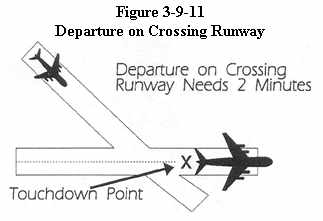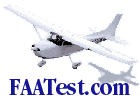| Section 9. Departure Procedures and Separation
Provide current departure information, as appropriate, to departing
aircraft. 1. Runway in use. (May be omitted if pilot states "have the numbers.")
REFERENCE - 1. To a VFR aircraft when weather is below VFR conditions. NOTE - e. Taxi information, as necessary. You need not issue taxi route
information unless the pilot specifically requests it. REFERENCE - REFERENCE - 3-9-2 Departure Delay Information USA/USAF/USN NOT APPLICABLE {New-98-3 Revised February 26, 1998} REFERENCE - PHRASEOLOGY - b. Advise departing aircraft when to start engines and/or to advise when ready to taxi. PHRASEOLOGY - PHRASEOLOGY - 3-9-3 Departure Control Instructions Inform departing IFR, SVFR, VFR aircraft receiving radar service, and
TRSA VFR of the following: {New-98-8 Revised August 13, 1998. "DP" was "SID"} 1. Issue the appropriate departure control frequency and beacon code. The departure control frequency may be omitted if a DP has been or will be assigned and the departure control frequency is published on the DP. PHRASEOLOGY - 2. Inform all departing IFR military turboprop/turbojet aircraft (except transport and cargo types) to change to departure control frequency. If the local controller has departure frequency override, transmit urgent instructions on this frequency. If the override capability does not exist, transmit urgent instructions on the emergency frequency. PHRASEOLOGY - 1. When the aircraft is about 1/2 mile beyond the runway end, instruct
civil aircraft and military transport and cargo types to contact departure
control provided further communication with you is not required. REFERENCE - a. Authorize an aircraft to taxi into position and hold, except as restricted in subparagraph e, when takeoff clearance cannot be issued because of traffic. Issue traffic information to any aircraft so authorized. Traffic information may be omitted when the traffic is another aircraft which has landed on or is taking off the same runway and is clearly visible to the holding aircraft. Do not use conditional phrases such as "behind landing traffic" or "after the departing aircraft." b. USN NOT APPLICABLE. First state the runway number followed by the taxi into position clearance when more than one runway is active. PHRASEOLOGY - TAXI INTO POSITION AND HOLD. EXAMPLE - PHRASEOLOGY - REFERENCE - 1. HOLD SHORT OF RUNWAY, or h. USAF/USN: When issuing additional instructions or information to an aircraft holding in takeoff position, include instructions to continue holding or taxi off the runway, unless it is cleared for takeoff. PHRASEOLOGY - Takeoff clearance need not be withheld until prescribed separation exists if there is a reasonable assurance it will exist when the aircraft starts takeoff roll. Separate a departing aircraft from a preceding departing or arriving aircraft using the same runway by ensuring that it does not begin takeoff roll until: a. The other aircraft has departed and crossed the runway end or turned to avert any conflict. If you can determine distances by reference to suitable landmarks, the other aircraft need only be airborne if the following minimum distance exists between aircraft: (See Figure 3-9-1 and Figure 3-9-2). 1. When only Category I aircraft are involved - 3,000 feet.
Figure 3-9-2 NOTE - {New-98-3 Revised February 26, 1998} Category I - small aircraft weighing 12,500 lbs. or less, with a
single propeller driven engine, and all helicopters. b. A preceding landing aircraft is clear of the runway. (See Figure
3-9-3)
REFERENCE - WAKE TURBULENCE APPLICATION {New-98-3 Revised February 26, 1998} REFERENCE - {New-98-3 Revised February 26, 1998} e. The minima in paragraph 5-5-3, Minima, may be applied in lieu of the 2-minute requirement in subparagraph f. When paragraph 5-5-3, Minima, are applied, ensure that the appropriate radar separation exists at or prior to the time an aircraft becomes airborne when taking off behind a heavy jet/B757. NOTE - {New-98-3 Revised February 26, 1998} f. Separate IFR/VFR aircraft taking off behind a heavy jet/B757 departure by 2 minutes, when departing: {New-98-3 Revised February 26, 1998} NOTE - 1. The same runway. (See Figure 3-9-4)
2. A parallel runway separated by less than 2,500 feet. {New-98-3 Revised February 26, 1998} g. Separate an aircraft from a heavy jet/B757 when operating on a runway with a displaced landing threshold if projected flight paths will cross - 2 minutes when: 1. A departure follows a heavy jet/B757 arrival. {New-98-3 Revised February 26, 1998} h. Air traffic controllers shall not approve pilot requests to deviate
from the required wake turbulence time interval if the preceding aircraft is a
heavy jet/B757. NOTE - {New-98-3 Revised February 26, 1998} REFERENCE - {New-98-3 Revised February 26, 1998} j. Separate aircraft behind a heavy jet/B757 departing or making a
low/missed approach when utilizing opposite direction takeoffs or landings on
the same or parallel runways separated by less than 2,500 feet - 3 minutes.
PHRASEOLOGY - REFERENCE - 3-9-7 Wake Turbulence Separation for Intersection Departures a. Apply the following wake turbulence criteria for intersection
departures: {New-98-3 Revised February 26, 1998} 2. Separate any aircraft taking off from an intersection on the same runway (same or opposite direction takeoff) and parallel runways separated by less than 2,500 feet, by ensuring that the aircraft does not start takeoff roll until at least 3 minutes after a heavy aircraft/B757 has taken off. {New-98-3 Revised February 26, 1998} 3. Separate a small aircraft weighing 12,500 lbs. or less taking off from an intersection on the same runway (same or opposite direction takeoff) behind a preceding small aircraft weighing more than 12,500 lbs. by ensuring the following small aircraft does not start take-off roll until at least 3 minutes after the preceding aircraft has taken off. {New-98-3 Added February 26, 1998} 4. Inform an aircraft when it is necessary to hold in order to provide the required 3-minute interval. PHRASEOLOGY - NOTE - REFERENCE - {New-98-3 Revised February 26, 1998} 1. A pilot has initiated a request to deviate from that interval unless the preceding departing aircraft is a heavy aircraft/B757. NOTE - 2. USA NOT APPLICABLE. The intersection is 500 feet or less from the departure point of the preceding aircraft and both aircraft are taking off in the same direction. {New-98-3 Revised February 26, 1998} 3. Successive touch-and-go and stop-and-go operations are conducted with a small aircraft following another small aircraft weighing more than 12,500 lbs. or a large aircraft in the pattern, or a small aircraft weighing more than 12,500 lbs. or large aircraft departing the same runway, provided the pilot of the small aircraft is maintaining visual separation/spacing behind the preceding large aircraft. Issue a wake turbulence cautionary advisory and the position of the large aircraft. EXAMPLE - "Caution wake turbulence, DC-9 on base leg." {New-98-3 Revised February 26, 1998} 4. Successive touch-and-go and stop-and-go operations are conducted with any aircraft following a heavy aircraft/B757 in the pattern, or heavy aircraft/B757 departing the same runway, provided the pilot of the aircraft is maintaining visual separation/spacing behind the preceding heavy aircraft/B757. Issue a wake turbulence cautionary advisory and the position of the heavy aircraft/B757. EXAMPLE - c. When applying the provision of subparagraph b: 1. Issue a wake turbulence advisory before clearing the aircraft for
takeoff. REFERENCE - 3-9-8 Intersecting Runway Separation Separate departing aircraft from an aircraft using an intersecting runway, or nonintersecting runways when the flight paths intersect, by ensuring that the departure does not begin takeoff roll until one of the following exists: a. The preceding aircraft has departed and passed the intersection, has
crossed the departure runway, or is turning to avert any conflict. (See Figure
3-9-5 and Figure 3-9-6)
b. A preceding arriving aircraft is clear of the landing runway, completed the landing roll and will hold short of the intersection, passed the intersection, or has crossed over the departure runway. (See Figure 3-9-7 and Figure 3-9-8). REFERENCE -
WAKE TURBULENCE APPLICATION {New-98-3 Revised February 26, 1998} c. Separate IFR/VFR aircraft taking off behind a heavy jet/B757 departure by 2 minutes when departing: {New-98-3 Revised February 26, 1998} NOTE - 1. Crossing runways if projected flight paths will cross. (See Figure
3-9-9).
{New-98-3 Revised February 26, 1998} d. Separate IFR/VFR aircraft departing behind a landing heavy jet/B757
on a crossing runway if the departure will fly through the airborne path of the
arrival - 2 minutes. (See Figure 3-9-11).
{New-98-3 Revised February 26, 1998} e. Air traffic controllers shall not approve pilot requests to deviate from the required wake turbulence time interval if the preceding aircraft is a heavy jet/B757. REFERENCE - a. When only one runway is active, issue takeoff clearance. PHRASEOLOGY - NOTE - REFERENCE - b. When more than one runway is active, first state the runway number followed by the takeoff clearance. PHRASEOLOGY - EXAMPLE - {New-98-3 Revised February 26, 1998} c. USA/USN/USAF: Issue surface wind and takeoff clearance to aircraft. PHRASEOLOGY - d. USAF: When an aircraft is cleared for takeoff, inform it of the closest traffic within 6 miles on final approach to the same runway. If the approaching aircraft is on a different frequency, inform it of the departing aircraft. 3-9-10 Cancellation of Takeoff Clearance Cancel a previously issued clearance for takeoff and inform the pilot of the reason if circumstances require. Once an aircraft has started takeoff roll, cancel the takeoff clearance only for the purpose of safety. NOTE - PHRASEOLOGY -
|









